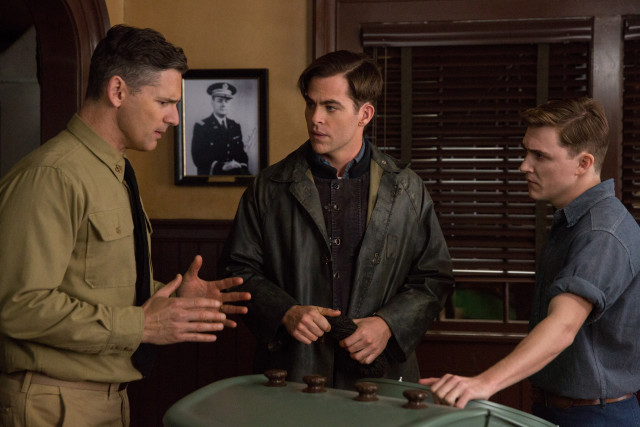To understand the truth behind the dramatic scenes depicted in THE FINEST HOURS we spoke to JoJo Mains who worked for the US Coast Guard and now works for the Royal National Lifeboat Institution (RNLI) charity in the UK as Community Safety Intelligence Manager. Speaking with JoJo we understand some of the shocking moments from this true story that Hollywood got right.

Crossing ‘The Bar’
In one dramatic scene Chris Pine, who plays Coxswain Bernie Webber, can be seen crossing the Bar, but what is a ‘bar’? Most people will be unfamiliar with the term says JoJo, “basically if you think of the energy of the ocean waves, that energy exists deep into the ocean and as it approaches a very shallow area, the energy has to go somewhere so it goes up. But what makes it difficult,” JoJo continues, “is when you have a wind, so you have two different forces working against each other that create a sort of convergence, and it’s this convergence that makes the water in the ocean stand up even higher.” Volunteer RNLI crew members who respond to emergency calls in UK and Irish waters can be exposed to the same forces of nature today.
Having been to Chatham with the US Coast Guard where the dramatic rescue took place, JoJo was aware of the Bar and how difficult it must have been for the crew in 1952. As he is quick to point out, “obviously I am not sure on the exact conditions of the day in 1952, but what you see in the film, is probably one of those situations where Hollywood understated the situation of the team crossing the Bar.”
JoJo praises the similarities between the film and real life situations on the sea, “the scene where the Coxwain (Chris Pine) closes his eyes to count is real, to this day guys still do it, and I used to do it. Station Chatham, where the team were based, is on the outer arm of Massachusetts Bay where it is exposed to the entire Atlantic Ocean, so when the wind comes from the North East it creates mayhem in that part of the world. When we see Bernie closing his eyes and counting as he crosses the Bar, he is counting the waves and listening for his opportunity to cross the Bar. There is no magic piece of technology that allows you to do that, but there is night vision and other things available now which these guys simply would not have had. I was so impressed by that tiny fact that was shown in the film, it was so factual.”
Instinct
JoJo stresses some of the events that take place in the film may not even seem possible, “there is a part in the film which most people will think is pretty unrealistic; for example when the rescue boat goes completely underwater and looks like a submarine. It is not ideal but surprisingly it can happen
and the way it was depicted in the movie was really well done.”
“The fact that these men were also operating the rescue boat with their compass ripped off is also realistic” (though not possible today). “Back in 1952 this boat would have been classed nonoperational and they should have gone home! But”, JoJo continues, “Some elements did work in the crew’s favour. Once they had crossed the Bar, the ocean will start to swell but it’s not crashing on you so the crew would have had a bit of manoeuvrability in these conditions.”
JoJo is aware the crew would have used their own navigational skills with a lack of compass, “you go back to seriously old school navigation, wind is coming from the north east so that is the direction of the north east. If you can orientate yourself to the wind, then you can orientate yourself to the sea –
as we see in the film you can hear the crashing bar in the distance.” JoJo concludes; “For anybody to go out in those conditions and do anything other than just surviving is quite remarkable. In 1952, without the tools of that day on board is frankly unbelievable.”
Against the elements
Their local knowledge of the area is also something that aided the crew in their mission to rescue the survivors. As JoJo reveals, “what some stations do is make crew members draw a map or a chart of their area of responsibility, you basically have to draw this from your memory, it is one of the steps that is used to become qualified.” When JoJo reflects on the scene in the film when the boat is completely submerged underwater he notes “the fear of going under is being ripped from the boat by the force of the water, this was a classic case of wide-eyed and white-knuckled, you would have held on as best you could! In addition you have the bitter stinging cold, it’s basically like being in 20 or 30 mph car crash every 12 to 5 seconds.”
In fact, in the actual 1952 rescue Bernie Webber was badly injured when the boat was submerged in the water. The crew recall seeing him come back up from the water with glass in his cheek. As JoJo adds, “he got all kinds of stuff embedded in his skull when the water blew out the windows and the crew of the Pendleton (the ship that was quickly sinking) were also injured from being thrown around in the engine room.”
The rescue mission itself is hailed as the greatest rescue in US Coast Guard history. Bernie Webber and his crew on the CG36500 rescue boat managed to save the lives of 32 crew members from the sinking SS Pendleton. The four crew members who endured this daring mission were all awarded the Coast Guard’s Gold Lifesaving Medal.
The Finest Hours is in UK cinemas from February 19th.

